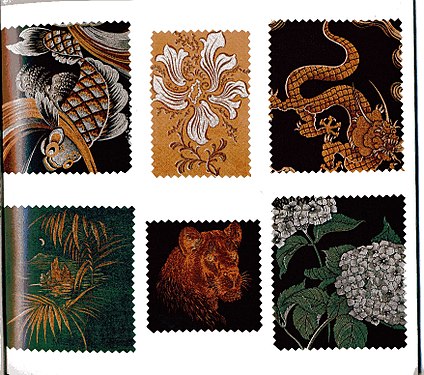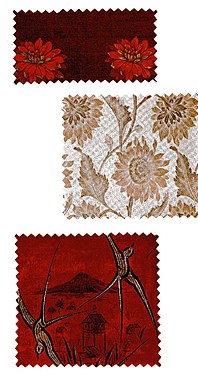G. Hollender sons
| G. Hollender & Sons
|
|
|---|---|
| legal form | GmbH & Co. KG |
| founding | 1842 |
| resolution | 2006 |
| Seat | Krefeld |
| Branch | Silk weaving |
The companies G. Hollender Sons and Peter Bircks & Cie. , Both based in the silk weaving town Krefeld , were essentially the only special fur silk , rayon , semi-silk and pure silk for furnishing fur clothing manufactured and sold worldwide. The specialization in fur silks gave them a certain monopoly position in Germany for this trade article . G. Hollender Söhne's extensive export business at an early stage contributed to making “Krefeld silk” a household name around the world.
history
In 1842 the silk factory Hollender & Schelleckes was founded in Krefeld, then still called Crefeld , by Gerhard Hollender and Konrad Schelleckes . The factory and the delivery of the silk yarns for the home weavers was on the property Nordwall 55. The profession of home weaver was long characteristic of the Lower Rhine area. When Konrad Schellecke gave up his partnership after years, the two Hollender sons joined the company and the company name was changed to G. Hollender Sons .
Even then, the company was producing many different qualities, primarily fine fur lining silk and lapel silk, all of which were still woven from natural silk. It also included fabrics for colorful silk vests and elegant collared velvets . At the time, the range comprised over 150 designs and qualities in fur lining silks alone, plus around 125 articles made of lapel silk and 80 designs in vest fabrics, as well as a large range of men's lining silks in full and half silk.
In the 1890s, Hollender had around 250 employees, including home weavers. In line with the steadily growing volume of business, the factory was completely mechanized with the newly developed looms . At the turn of the 20th century, G. Hollender Söhne had an extensive network of distribution centers and agencies in Europe. The company had new and larger factory and administration buildings built on Weggenhofstrasse, and the new weaving mill went into operation in 1913. Shortly after the First World War , Walther Hollender took over management of the company, reestablished the European business relationships that had been interrupted due to the war and expanded them further. In 1924 the new material rayon made of viscose fibers was added to the range.
During the Second World War , the entire machine park was destroyed, but production could continue in a friendly weaving mill. The company on Weggenhofstrasse was rebuilt in 1949 using the latest and most powerful machines. More recent findings meant that the machine park was supplemented with the most modern fully automatic machines a few years later.
Natural silk and rayon were woven in a variety of ways. In 1967 over 30 percent of the products were exported. An essential part of the production was concerned with the production of body lining silk for the ladies and gents tailoring . The main part, however, continued to be made by the production of fur silks, the company's motto was: "For noble fur, the noble silk". Their specialties there were pure silk and high-quality artificial silk crepe Marocs , Crêpesatins and Duchesses . At least after the war, all fur ingredients and tools required by skinning were also carried .
One descendant, Paul Hollender (born June 30, 1883 in Krefeld, † September 28, 1950 in Cape Town ), actually intended to take over the family business one day. However, he married Ella Thorer (* 1884, † 1950) from the old Leipzig fur trader family Thorer, and when his father-in-law Paul Thorer suggested that he join his family's company, he gave in to its insistence. In 1925, the New York branch was renamed Thorer & Hollender Inc. , and in 1932 the subsidiary Thorer & Hollender was founded in Leipzig to sell fox skins .
The silk weaving mill G. Hollender Söhne GmbH & Co. KG went out on October 8, 2006. In 2018, there were still stocks left at the H. Espey fur ingredients store in Gladbeck .
- Silk pattern, around 1900
Web links
Individual evidence
- ↑ a b c d e f 125 years of silk weaving G. Holländer Sons Krefeld. Krefeld 1967.
- ^ Advertisement for the fur fair 1950 , the second fur fair after the war. In the exhibition catalog: Frankfurter Rauchwarenmesse and novelty exhibition with a performance exhibition of the furrier trade 1950 .
- ↑ display . In: Winckelmann, Fachadressbuch der Rauchwaren- u. Fur industry and the furrier trade for Germany , 96th edition, 1988, book cover.
- ↑ Otto Nauen: In Memoriam Dr. hc Paul Hollender. (for the commemoration in the auditorium of the Johann Wolfgang Goethe University in Frankfurt am Main on November 15, 1950) Frankfurt am Main 1950, p. 8.
- ^ Theodor Thorer: 325 years of the Thorer family. 75 years of Theodor Thorer. Leipzig 1937, p. 150.
- ^ Thorer & Hollender (eds.): 350 years of Thorer . Frankfurt am Main 1962, p. 125, descendant p. 133.
- ↑ https://www.kompany.com ( Memento of the original from June 17, 2018 in the Internet Archive ) Info: The archive link was inserted automatically and has not yet been checked. Please check the original and archive link according to the instructions and then remove this notice. : Hollender limited company . Retrieved October 23, 2017.



